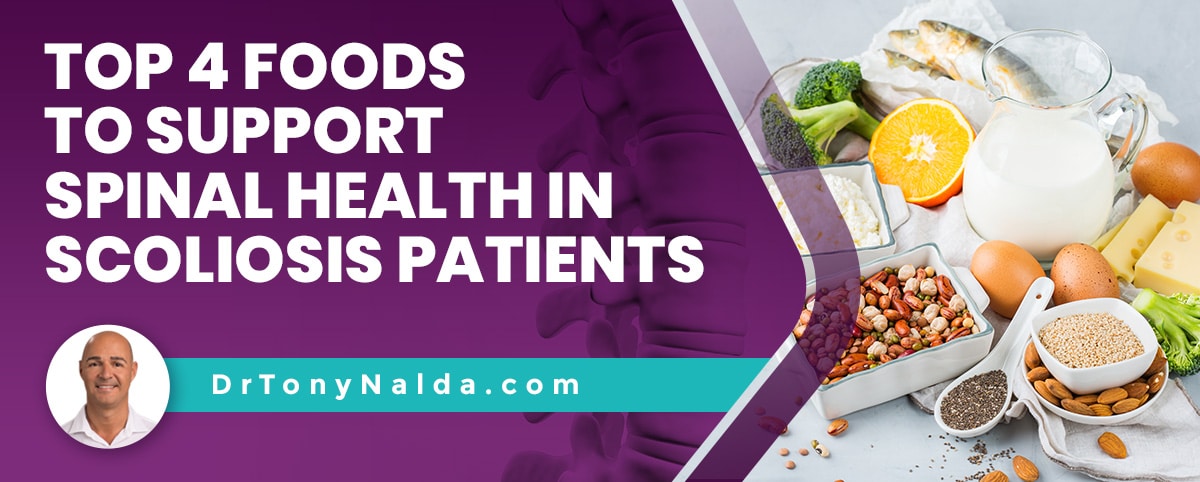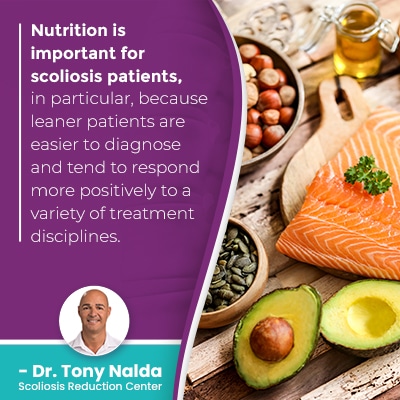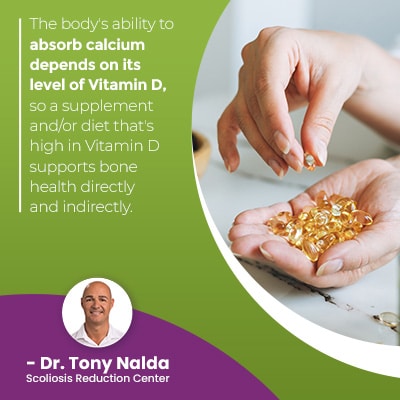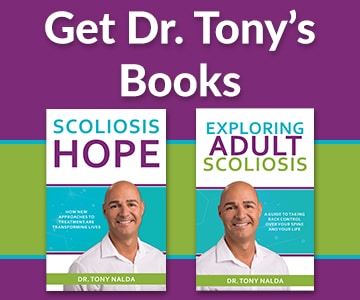Top 4 Foods to Support Spinal Health in Scoliosis Patients

Leading a spine-friendly lifestyle includes good posture, a healthy weight and activity level, and a healthy diet. A healthy diet that includes fruits and vegetables, lean non processed meats, foods high in Vitamins D and calcium, and lots of water is important for supporting a spine- and scoliosis-friendly lifestyle.
There are many variables that factor into how a scoliosis patient responds to their condition and to treatment. While a healthy diet alone can't correct scoliosis, it can help create an environment inside the body that's conducive to healing and supports bone health.
When shopping for groceries, if you, or someone you're caring for, is living with scoliosis, consider the types of foods that are known to support bone health and overall health.
Table of Contents
What is Scoliosis?
Scoliosis causes the spine to bend to the side unnaturally and twist and as a progressive condition, its nature is to get worse over time.
Scoliosis can affect all ages and ranges in severity from mild scoliosis to moderate, severe and very severe scoliosis.
There are also different types of the condition with unique causes, symptoms,and treatment needs.
The most common type of scoliosis to affect all ages is idiopathic scoliosis that has no known cause, and this type accounts for approximately 80 percent of known cases, and the remaining 20 percent consist of known causes: neuromuscular scoliosis, degenerative scoliosis, and congenital scoliosis.
Neuromuscular scoliosis is caused by a larger neuromuscular condition like spina bifida, cerebral palsy, and muscular dystrophy.
The most important part of treating scoliosis is impacting it on a structural level so that's my priority, but once I see structural results and the curve size being reduced, diet and exercise are addressed shortly thereafter.
Scoliosis and Diet
As scoliosis is such a highly-variable condition, treatment plans needs to be fully customized, and when it comes to treating the whole patient, this means addressing all symptoms and aspects of their lifestyle, including diet.
 Nutrition is important for scoliosis patients, in particular, because leaner patients are easier to diagnose and tend to respond more positively to a variety of treatment disciplines.
Nutrition is important for scoliosis patients, in particular, because leaner patients are easier to diagnose and tend to respond more positively to a variety of treatment disciplines.
As links have been found between a deficiency in neurotransmitters and scoliosis onset, a diet that's rich in amino acids (the precursors to neurotransmitters) can increase the body's natural production of neurotransmitters.
It's also been found that scoliosis patients can't methylate the vitamin B12 properly, and this further hampers the body's ability produce neurotransmitters, so it's recommended that scoliosis patients take methylated B12 to help boost neurostransmitter production.
Scoliosis is also associated with lower bone density, so bone health is important, and mineral supplements as part of a healthy diet, and a diet high in calcium, can help promote bone health and repair.
A health diet improves overall health which means more energy to endure the rigors of treatment, and more energy also tends to mean better mental health. We all know how far a good attitude goes when dealing with challenges.
A healthy diet can also reduce the likelihood that patients are dealing with inflammation, known to cause a number of issues.
So what are 4 foods that should be added to a scoliosis patient's grocery list?
1) Fresh Fruits and Vegetables
Fresh fruits and vegetables provide a number of essential nutrients for the body; they are also high in fiber and their consumption is known to reduce the risk of a number of diseases; they are healthy carbohydrates that contain vitamins essential to cellular health and repair.
When possible, fresh is always best, but frozen fruits and vegetables are better than no fruits and vegetables.
2) Foods High in Calcium and Vitamin D
There are a number of theories regarding what causes the onset of idiopathic scoliosis, and in general, it's thought to be multifactorial.
A theory that's supported by studies is that poor bone health can play a role, so diets high in calcium and Vitamin D promote healthy and strong bones.
As the spine consists of vertebrae (bones), a diet that focuses on bone health can help make the spine healthier and more functional.
Seeds, nuts, and beans are high in calcium, as are dairy products, so chia seeds, almonds, lentils, and legumes are healthy sources of calcium.
 The body's ability to absorb calcium depends on its level of Vitamin D, so a supplement and/or diet that's high in Vitamin D supports bone health directly and indirectly.
The body's ability to absorb calcium depends on its level of Vitamin D, so a supplement and/or diet that's high in Vitamin D supports bone health directly and indirectly.
3) Lean Non-Processed Meat
A diet high in lean non-processed meat is one that's high in protein, and protein is essential for muscle health and growth.
Muscle health is a focus of scoliosis treatment. It's not just the spine that has to maintain its natural curves and alignment; it's also the role of the spine's surrounding muscles to provide it with support and stability.
Lean chicken, beef, turkey, and fish can help keep the body's muscles strong and healthy so they can optimally support the spine throughout treatment and beyond.
4) Water: Stay Hydrated
Staying hydrated is important for overall health, and when it comes to spinal health, the discs that sit between adjacent vertebrae need to stay hydrated to stay healthy.
The discs give the spine structure, flexibility, prevent friction, and act as the spine's shock absorbers, and when we're born, they are made largely of water, but as we age, they lose fluid, and if they experience excessive fluid loss, they can start to degenerate, and this can disrupt the health of the entire spine.
Discs don't have their own vascular supply; they absorb fluid and nutrients needed for repair from their surroundings, so increasing circulation and staying hydrated is key to disc health which is key to overall spinal health and function.
So in addition to a healthy diet, what else can people with scoliosis do to improve their condition?
The Importance of Proactive Scoliosis Treatment
When it comes to living with scoliosis, the best way to minimize the condition's effects is to treat it proactively.
As a progressive condition, its effects get more severe over time, and the more a condition progresses, the more complex it is to treat, the more overt its effects will be, and the harder it can be to improve.
Being proactive with treatment means working towards preventing progression, rather than attempting to reverse its effects once they're established.
Scoliosis can be highly treatable when it's approached proactively and conservatively.
Nonsurgical Scoliosis Treatment
Conservative treatment is nonsurgical and integrative; it combines the power of chiropractic care, physical therapy, scoliosis exercises, corrective bracing, and rehabilitation.
There are never treatment guarantees, but in most cases, the sooner treatment is started, the better.
When applied early, the spine can be more responsive to treatment, and for those leading a scoliosis-friendly lifestyle, including diet, a healthier body can mean a healthier spine.
Chiropractic care is applied to reduce the curve on a structural level, while physical therapy and exercises are designed to improve the spine's surrounding muscle balance and strength, and correctibe bracing helps by pushing the spine into a corrective position.
As scoliosis is a progressive condition, it's going to be ongoing, and rehabilitation can include continued chiropractic care and the prescription of a scoliosis-specific exercises that can be done from home to further heal and rehabilitate the spine.
During the rehabilitation phase of treatment, I review lifestyle practices that support a spine- and scoliosis-friendly lifestyle, including weight, activity levels, and diet.
Conclusion
Scoliosis patients need to be particularly mindful of their health as it can help prepare the body for treatment, make it more responsive, and treatment success more likely.
In addition, a scoliosis-friendly diet can mean healthy bones and vitamin levels, a healthy weight, and reduced inflammation.
A diet high in fruits and vegetables, leafy green vegetables, offers a natural sugar high without the associated risks of foods high in processed sugars and vitamins (vitamin k, healthy magnesium levels, vitamin c) needed for cellular health and repair.
Foods high in calcium and vitamin D include nuts, seeds, beans and fish. Vitamin D supplements are also readily available, and as most people are lacking Vitamin D, introducing it into a diet can mean healthier bones, a healthier spine, and a healthier body in general.
Scoliosis onset has also been linked to a vitamin d deficiency so supplements can help maintain healthy consistent vitamin d levels.
Non-processed lean meats such as turkey and chicken are high in lean protein and help with improving muscle health and strength: a focus of nonsurgical scoliosis treatment.
While not a food, it's critical for overall health, and spine health, that proper hydration is maintained, particularly during times of heat and/or exertion; a dehydrated body means it's having to work harder, and this affects spinal health by contributing to disc desiccation: associated with a number of spinal issues, including scoliosis.
A diet that's low in added sugar, fast food, excessive salt, and rich in the aforementioned foods is one that promotes a healthy immune system, tissue health, and overall bone health.
Dr. Tony Nalda
DOCTOR OF CHIROPRACTIC
After receiving an undergraduate degree in psychology and his Doctorate of Chiropractic from Life University, Dr. Nalda settled in Celebration, Florida and proceeded to build one of Central Florida’s most successful chiropractic clinics.
His experience with patients suffering from scoliosis, and the confusion and frustration they faced, led him to seek a specialty in scoliosis care. In 2006 he completed his Intensive Care Certification from CLEAR Institute, a leading scoliosis educational and certification center.
About Dr. Tony Nalda
 Ready to explore scoliosis treatment? Contact Us Now
Ready to explore scoliosis treatment? Contact Us Now





